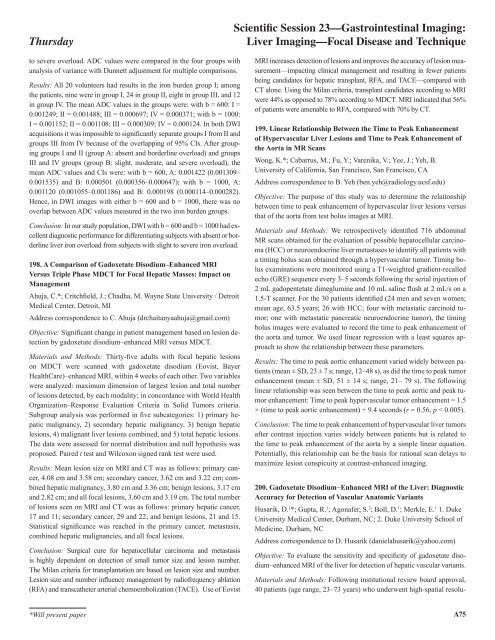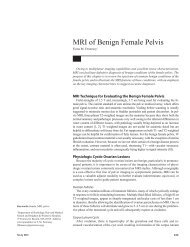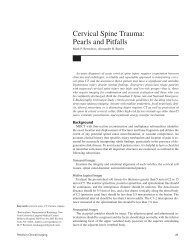Scientific Session 1 â Breast Imaging: Mammography
Scientific Session 1 â Breast Imaging: Mammography
Scientific Session 1 â Breast Imaging: Mammography
You also want an ePaper? Increase the reach of your titles
YUMPU automatically turns print PDFs into web optimized ePapers that Google loves.
Thursday<strong>Scientific</strong> <strong>Session</strong> 23—Gastrointestinal <strong>Imaging</strong>:Liver <strong>Imaging</strong>—Focal Disease and Techniqueto severe overload. ADC values were compared in the four groups withanalysis of variance with Dunnett adjustment for multiple comparisons.Results: All 20 volunteers had results in the iron burden group I; amongthe patients, nine were in group I, 24 in group II, eight in group III, and 12in group IV. The mean ADC values in the groups were: with b = 600: I =0.001249; II = 0.001488; III = 0.000697; IV = 0.000371; with b = 1000:I = 0.001152; II = 0.001108; III = 0.000309; IV = 0.000124. In both DWIacquisitions it was impossible to significantly separate groups I from II andgroups III from IV because of the overlapping of 95% CIs. After groupinggroups I and II (group A: absent and borderline overload) and groupsIII and IV groups (group B: slight, moderate, and severe overload), themean ADC values and CIs were: with b = 600, A: 0.001422 (0.001309–0.001535) and B: 0.000501 (0.000356–0.000647); with b = 1000, A:0.001120 (0.001055–0.001186) and B: 0.000198 (0.000114–0.000282).Hence, in DWI images with either b = 600 and b = 1000, there was nooverlap between ADC values measured in the two iron burden groups.Conclusion: In our study population, DWI with b = 600 and b = 1000 had excellentdiagnostic performance for differentiating subjects with absent or borderlineliver iron overload from subjects with slight to severe iron overload.198. A Comparison of Gadoxetate Disodium–Enhanced MRIVersus Triple Phase MDCT for Focal Hepatic Masses: Impact onManagementAhuja, C.*; Critchfield, J.; Chadha, M. Wayne State University / DetroitMedical Center, Detroit, MIAddress correspondence to C. Ahuja (drchaitanyaahuja@gmail.com)Objective: Significant change in patient management based on lesion detectionby gadoxetate disodium–enhanced MRI versus MDCT.Materials and Methods: Thirty-five adults with focal hepatic lesionson MDCT were scanned with gadoxetate disodium (Eovist, BayerHealthCare)–enhanced MRI, within 4 weeks of each other. Two variableswere analyzed: maximum dimension of largest lesion and total numberof lesions detected, by each modality; in concordance with World HealthOrganization–Response Evaluation Criteria in Solid Tumors criteria.Subgroup analysis was performed in five subcategories: 1) primary hepaticmalignancy, 2) secondary hepatic malignancy, 3) benign hepaticlesions, 4) malignant liver lesions combined, and 5) total hepatic lesions.The data were assessed for normal distribution and null hypothesis wasproposed. Paired t test and Wilcoxon signed rank test were used.Results: Mean lesion size on MRI and CT was as follows: primary cancer,4.08 cm and 3.58 cm; secondary cancer, 3.62 cm and 3.22 cm; combinedhepatic malignancy, 3.80 cm and 3.36 cm; benign lesions, 3.17 cmand 2.82 cm; and all focal lesions, 3.60 cm and 3.19 cm. The total numberof lesions seen on MRI and CT was as follows: primary hepatic cancer,17 and 11; secondary cancer, 29 and 22; and benign lesions, 21 and 15.Statistical significance was reached in the primary cancer, metastasis,combined hepatic malignancies, and all focal lesions.Conclusion: Surgical cure for hepatocellular carcinoma and metastasisis highly dependent on detection of small tumor size and lesion number.The Milan criteria for transplantation are based on lesion size and number.Lesion size and number influence management by radiofrequency ablation(RFA) and transcatheter arterial chemoembolization (TACE). Use of EovistMRI increases detection of lesions and improves the accuracy of lesion measurement—impactingclinical management and resulting in fewer patientsbeing candidates for hepatic transplant, RFA, and TACE—compared withCT alone. Using the Milan criteria, transplant candidates according to MRIwere 44% as opposed to 78% according to MDCT. MRI indicated that 56%of patients were amenable to RFA, compared with 70% by CT.199. Linear Relationship Between the Time to Peak Enhancementof Hypervascular Liver Lesions and Time to Peak Enhancement ofthe Aorta in MR ScansWong, K.*; Cabarrus, M.; Fu, Y.; Varenika, V.; Yee, J.; Yeh, B.University of California, San Francisco, San Francisco, CAAddress correspondence to B. Yeh (ben.yeh@radiology.ucsf.edu)Objective: The purpose of this study was to determine the relationshipbetween time to peak enhancement of hypervascular liver lesions versusthat of the aorta from test bolus images at MRI.Materials and Methods: We retrospectively identified 716 abdominalMR scans obtained for the evaluation of possible hepatocellular carcinoma(HCC) or neuroendocrine liver metastases to identify all patients witha timing bolus scan obtained through a hypervascular tumor. Timing bolusexaminations were monitored using a T1-weighted gradient-recalledecho (GRE) sequence every 3–5 seconds following the serial injection of2 mL gadopentetate dimeglumine and 10 mL saline flush at 2 mL/s on a1.5-T scanner. For the 30 patients identified (24 men and seven women;mean age, 63.5 years; 26 with HCC; four with metastatic carcinoid tumor;one with metastatic pancreatic neuroendocrine tumor), the timingbolus images were evaluated to record the time to peak enhancement ofthe aorta and tumor. We used linear regression with a least squares approachto show the relationship between these parameters.Results: The time to peak aortic enhancement varied widely between patients(mean ± SD, 23 ± 7 s; range, 12–48 s), as did the time to peak tumorenhancement (mean ± SD, 51 ± 14 s; range, 21– 79 s). The followinglinear relationship was seen between the time to peak aortic and peak tumorenhancement: Time to peak hypervascular tumor enhancement = 1.5× (time to peak aortic enhancement) + 9.4 seconds (r = 0.56, p < 0.005).Conclusion: The time to peak enhancement of hypervascular liver tumorsafter contrast injection varies widely between patients but is related tothe time to peak enhancement of the aorta by a simple linear equation.Potentially, this relationship can be the basis for rational scan delays tomaximize lesion conspicuity at contrast-enhanced imaging.200. Gadoxetate Disodium-Enhanced MRI of the Liver: DiagnosticAccuracy for Detection of Vascular Anatomic VariantsHusarik, D. 1 *; Gupta, R. 1 ; Agonafer, S. 2 ; Boll, D. 1 ; Merkle, E. 1 1. DukeUniversity Medical Center, Durham, NC; 2. Duke University School ofMedicine, Durham, NCAddress correspondence to D. Husarik (danielahusarik@yahoo.com)Objective: To evaluate the sensitivity and specificity of gadoxetate disodium–enhancedMRI of the liver for detection of hepatic vascular variants.Materials and Methods: Following institutional review board approval,40 patients (age range, 23–73 years) who underwent high-spatial resolu-*Will present paperA75
















